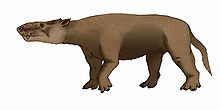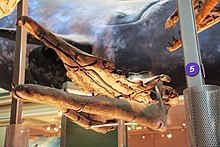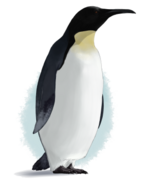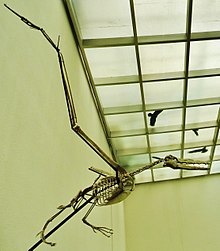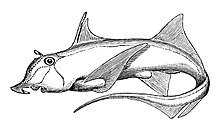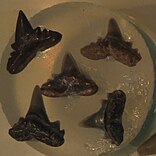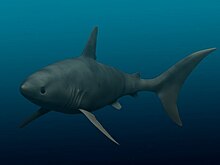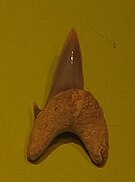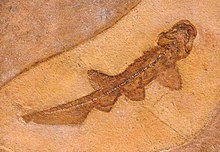This article is about an Antarctica sedimentary sequence. For the geological feature, see
Mesa . For other uses, see
Meseta .
The La Meseta Formation is a sedimentary sequence deposited during much of the Paleogene on Seymour Island off the coast of the Antarctic Peninsula . It is noted for its fossils, which include both marine organisms and the only terrestrial vertebrate fossils from the Cenozoic of Antarctica.[ 2] [ 4]
In some treatments, the La Meseta Formation is restricted to just the older Thanetian to Lutetian -aged strata, with the younger Bartonian to Rupelian strata treated as the overlying Submeseta Formation .[ 5] [ 6] [ 7] [ 8]
La Meseta Formation lies unconformably on the Cretaceous Lopez de Bertodano Formation . It is an approximately 557 metres (1,827 ft) thick sequence of poorly consolidated sandstones and siltstones . The depositional environment was probably coastal, deltaic or estuarine in character. The top of the sequence is an erosional unconformity to Pleistocene glacial gravels.[ 3] [ 2] Late Jurassic to Paleogene James Ross Basin .[ 3]
The terrestrial environment surrounding the deposition area is thought to have been a temperate polar forest, including podocarp and araucarian conifers, as well as Nothofagus .[ 9] [ 10] [ 11] [ 12]
La Meseta Formation is extremely rich in fossils. Among mammals, the meridiungulata Antarctodon Trigonostylops [ 13] [ 14] Derorhynchidae , Microbiotheria , and polydolopimorphia .[ 15] [ 16] Archaeospheniscus Palaeeudyptes [ 17] [ 18] Dasornis pseudotooth birds . There is also an abundance of trace fossils. Diplocraterion , Helminthopsis , Muensteria , Oichnus , Ophiomorpha , Skolithos , Teredolites and Zapfella have been described.[ 19] Ypresian Cucullaea bed.[ 3] [ 20]
Color key
Notes small text ; crossed out taxa are discredited.
Astrapotheria
Taxa
Species
Locality
Stratigraphic position
Material
Notes
Images
Antarctodon A. sobrali
Locality DVP 2/84 and IAA 1/90.
Cucullaea I allomember (Telm 5).
MLP 08-XI-30-1, an isolated right p4 or m1.
An astrapothere
Trigonostylops T. sp.
Cucullaea I allomember (Telm 5).
An astrapothere
Litopterna
Taxa
Species
Locality
Stratigraphic position
Material
Notes
Images
Notiolofos N. arquinotiensis
Locality IAA 1/13 and DPV 16/84.
Acantilados II, Campamento, Cucullaea I Allomember (Telm 4) and Submeseta Member (Telm 7).
A Brachyodont lower right molar fragment, probably m1 or m2, preserves a portion of the talonid with most of the lingual side (MLP 13-I-25-1) and left M3 incomplete (MLP 95-I-10-6).
A sparnotheriodontid litoptern .
N. regueroi
Locality IAA 2/16
Lower coquina bed of Cucullaea I Allomember.
IAA-PV 173, Isolated complete left m3.
Victorlemoinea V. sp.
Cucullaea I allomember (Telm 5).
A sparnotheriodontid litoptern.
Taxa
Species
Locality
Stratigraphic position
Material
Notes
Images
Basilosauridae [ 21] Indeterminate
Llanocetus L. denticrenatus
Locality DPV 10/84 and DVP 13/24.
Unit III Member and Telm 7.
A partial mandible with two teeth (specimen USNM 183022) and an endocast of the braincase.
A toothed baleen whale.
Derorhynchidae
Taxa
Species
Locality
Stratigraphic position
Material
Notes
Images
Derorhynchus [ 22] D. minutus [ 22] Locality IAA 1/90.
Allomember Cucullaea I (Telm 5).
MLP 96-1-5-44, incomplete right horizontal ramus of the dentary fragment with m2-3.
Pauladelphys [ 22] [ 23] P. juanjoi [ 22] [ 23] Locality IAA 2/95 and IAA 1/90.
Allomember Cucullaea I (Telm 5).
An isolated lower molar (MLP 95-1-10-2) and an upper left molar (MLP 96-1-5-44).
Xenostylos X. peninsularis [ 22] Locality IAA 1/90.
Allomember Cucullaea I (Telm 5).
MLP 94-111-15-10, an isolated upper right molar.
Microbiotheria
Taxa
Species
Locality
Stratigraphic position
Material
Notes
Images
Marambiotherium [ 22] M. glacialis [ 22] Locality IAA 1/90 and RV-8200.
Cucullaea I allomember (Telm 5).
MLP 95-1-10-1, a fragment of a right mandibular ramus with a complete m4 and the posterior alveolus of m3 and MLP 88-1-1-1, an edentulous left mandibular ramus with the alveoli for p3-m4.
A microbiothere , related to the modern monito del monte .
Woodburnodon W. casei Locality IAA 1/95.
Cucullaea I allomember (Telm 5).
MLP 04-III-1-2, an isolated, worn upper right molar (M2 or M3).
A microbiothere, related to the modern monito del monte.
Polydolopimorphia
Taxa
Species
Locality
Stratigraphic position
Material
Notes
Images
Antarctodolops A. dailyi
Locality IAA 2/95, DPV 2/84, and DPV 6/84.
Cucullaea I allomember (Telm 5).
UCR 20910, a left dentary with p3-m2.
A polydolopimorphian metatherian.
A. mesetaense
Locality IAA 1/90 and DPV 6/84.
Cucullaea I allomember (Telm 5).
Right dentary fragments.
Perrodelphys P. coquinense [ 22] Locality IAA 1/90.
Cucullaea I allomember (Telm 5).
MLP 96-1-5-11, an isolated left lower molar.
A polydolopimorphian metatherian.
Polydolops P. dailyi
Locality IAA 1/90 & DPV 3/84.
Cucullaea I allomember (Telm 5).
A polydolopimorphian metatherian.
P. seymouriensis
Locality IAA 1/90 & DPV 3/84.
Cucullaea I allomember (Telm 5).
P. thomasi
Locality IAA 1/90 & DPV 3/84.
Cucullaea I allomember (Telm 5).
Pujatodon P. ektopos [ 24] Locality IAA 1/90.
Cucullaea I Allomember (Telm 5).
Specimen MLP 14-I-10-20, a lower left molar (m2 or m3) partially worn.
A polydolopimorphian metatherian.
Taxa
Species
Locality
Stratigraphic position
Material
Notes
Images
Sudamerica S. ameghinoi
Locality IAA 1/90 upper level.
Cucullaea I Allomember.
MLP 95-I-10-5, anterior part of a left dentary with the rodent-like incisor partially preserved.
A gondwanathere
Meridiolestida ?[ 25] Indeterminate
Locality IAA 1/90 upper level.
Cucullaea I Allomember.
A single tooth, now lost.[ 25]
Xenarthra ?
Indeterminate.
Locality S124.
Cucullaea I Allomember/ Telm 4.
TMM 44190-1, left metacarpal II and A phalanx and a partial tooth[ 25]
Taxa
Species
Locality
Stratigraphic position
Material
Notes
Images
Anthropornis A. grandis
Locality IAA 4/12, IAA 1/90, DPV 13/84, and DVP 2/84.
Telm 4 member, Telm 7 member, and Submeseta Allomember.
Humerus: MLP 93-X-1-4 (proximal epiphysis), MLP 82-IV-23-4 (proximal epiphysis), MLP 83-I-1-190(proximal epiphysis) and MLP 88-I-1-463(proximal epiphysis).
A giant penguin .
Anthropornis Palaeeudyptes
A. nordenskjoldi [ 23]
Submeseta Allomember.
Humerus: MLP CX-60-25 (proximal epiphysis), MLP 83-V-30-5 (diaphysis) and MLP 93-X-1-104(complete humerus).
Archaeospheniscus A. lopdelli
Submeseta Allomember.
A giant penguin.
A. wimani
Submeseta Allomember.
Delphinornis [ 23] D. arctowskii
DPV 14/84
Cucullaea I Allomember (Telm 7).
A penguin.
D. graclis
DPV 14/84
Cucullaea I Allomember (Telm 7).
D. larseni
DPV 13/84 and DPV 14/84.
Cucullaea I Allomember (Telm 5 and Telm 7) and Submeseta Allomember.
Marambiornis M. exilis DVP 2/84, IAA 1/12, and ZPAL 4
Telm 7 Member.
A limb element (right tarsometatarsus ).
A penguin.
Mesetaornis M. polaris
Telm 7 member.
A nearly complete right femur and two distal left tibiotarsi.
A penguin.
Orthopteryx O. gigas [ 18]
A penguin.
Palaeeudyptes P. antarcticus
Cucullaea I Allomember (Telm 3, Telm 4, Telm 5, and Telm 7) and Submeseta Allomember.
A giant penguin.
P. gunnari [ 23] DVP 2/84, DVP 10/84, DVP 13/84, DVP 14/84, DVP 15/84, and ZPAL 4.
Cucullaea I Allomember (Telm 3, Telm 5, and Telm 7) and Submeseta Allomember.
Multiple specimens consist of coracoids, ulna, and humerus.
P. klekowskii DVP 2/84, DVP 10/84, DVP 13/84, DVP 14/84, DVP 16/84, and ZPAL 4.
Cucullaea I Allomember (Telm 3, Telm 5, and Telm 7) and Submeseta Allomember.
Several specimens consist of humerus, coracoid, ulna, and tibiotarsus.
Wimanornis W. seymourensis
DPV 14/84.
Cucullaea I Allomember (Telm 7) and Submeseta Allomember.
A penguin.
Tonniornis T. mesetaensis
DPV 14/84.
Cucullaea I Allomember (Telm 7) and Submeseta Allomember.
A penguin.
T. minimum
DPV 14/84.
Cucullaea I Allomember (Telm 7) and Submeseta Allomember.
Taxa
Species
Locality
Stratigraphic position
Material
Notes
Images
Calyptocephalella C. sp. [ 33] Locality IAA 2/95.
Cucullaea I Allomember (Telm 5).
The fragmentary right ilium (NRM-PZ B282) and a skull bone (NRM-PZ B281).
A calyptocephalellid frog
Taxa
Species
Locality
Stratigraphic position
Material
Notes
Images
Antarcticeras A. nordenskjoeldi
NRM 8, below IAA 1/90 (Ungulate Site).
Cucullaea I shell bed, Telm 4.
A fragmentary preserved straight shell.
An enigmatic cephalopod that is either considered a descendant of the orthocerids or an oegopsid squid.
Euciphoceras E . sp.
NRM 8, below IAA 1/90 (Ungulate Site).
Cucullaea I shell bed, Telm 4.
A fragmentary preserved straight shell.
A nautiloid .
^ Zinsmeister, Jeffrey D. Stilwell ; William J. (1992). Molluscan systematics and biostratigraphy : Lower Tertiary La Meseta Formation, Seymour Island, Antarctic Peninsula . Washington, DC: American Geophysical Union. ISBN 978-0875907703 {{cite book }}: CS1 maint: multiple names: authors list (link )^ a b c Pezzetti, T.F.; KRISSEK, L.A (1986). "Re-evaluation of the Eocene La Meseta Formation of Seymour Island, Antarctic Peninsula". Antarctic Journal of the United States . 21 (5): 75. ^ a b c d Reguero, Marcelo A.; Sergio A. Marenssi; Sergio N. Santillana (2012). "Weddellian marine/coastal vertebrates diversity from a basal horizon (Ypresian, Eocene) of the Cucullaea I Allomember, La Meseta formation, Seymour (Marambio) Island, Antarctica". Rev. Peru. Biol . 19 (3): 275– 284. doi :10.15381/rpb.v19i3.1006 . ^ Vega, Greta C.; Olalla-Tárraga, Miguel Ángel (2020), "Past changes on fauna and flora distribution" , Past Antarctica , Elsevier, pp. 165– 179, doi :10.1016/b978-0-12-817925-3.00009-4 , ISBN 978-0-12-817925-3 , retrieved 2023-09-20 ^ Acosta Hospitaleche, Carolina; Gelfo, Javier N. (2017-08-18). "Procellariiform remains and a new species from the latest Eocene of Antarctica" . Historical Biology . 29 (6): 755– 769. doi :10.1080/08912963.2016.1238470 . hdl :11336/54885 ISSN 0891-2963 . ^ a b c d Engelbrecht, Andrea; Mörs, Thomas; Reguero, Marcelo A.; Kriwet, Jürgen (2019-09-14). "Skates and rays (Elasmobranchii, Batomorphii) from the Eocene La Meseta and Submeseta formations, Seymour Island, Antarctica" . Historical Biology . 31 (8): 1028– 1044. Bibcode :2019HBio...31.1028E . doi :10.1080/08912963.2017.1417403 . ISSN 0891-2963 . PMC 6650296 PMID 31337928 . ^ Marenssi, Sergio A. (2006). "Eustatically controlled sedimentation recorded by Eocene strata of the James Ross Basin, Antarctica" . Geological Society, London, Special Publications . 258 (1): 125– 133. doi :10.1144/GSL.SP.2006.258.01.09 . ^ Reguero, Marcelo Alfredo; Marenssi, Sergio Alfredo; Santillana, S. N. (2012). "Weddellian marine/coastal vertebrates diversity from a basal horizon (Ypresian, Eocene) of the Cucullaea I Allomember, La Meseta formation, Seymour (Marambio) Island, Antarctica" . Revista Peruana de Biología . ISSN 1561-0837 . ^ Pujana, Roberto R.; Santillana, Sergio N.; Marenssi, Sergio A. (January 2014). "Conifer fossil woods from the La Meseta Formation (Eocene of Western Antarctica): Evidence of Podocarpaceae-dominated forests" . Review of Palaeobotany and Palynology . 200 : 122– 137. Bibcode :2014RPaPa.200..122P . doi :10.1016/j.revpalbo.2013.09.001 . hdl :11336/17151 ^ Reguero, Marcelo A.; Marenssi, Sergio A.; Santillana, Sergio N. (May 2002). "Antarctic Peninsula and South America (Patagonia) Paleogene terrestrial faunas and environments: biogeographic relationships" . Palaeogeography, Palaeoclimatology, Palaeoecology . 179 (3– 4): 189– 210. Bibcode :2002PPP...179..189R . doi :10.1016/S0031-0182(01)00417-5 . ^ Pujana, R. R., Wilf, P., & Gandolfo, M. A. (2020). Conifer wood assemblage dominated by Podocarpaceae, early Eocene of Laguna del Hunco, central Argentinean Patagonia. PhytoKeys, 156, 81–102. https://doi.org/10.3897/phytokeys.156.54175
^ a b Friis, Else M.; Iglesias, Ari; Reguero, Marcelo A.; Mörs, Thomas (2017-08-01). "Notonuphar antarctica, an extinct water lily (Nymphaeales) from the Eocene of Antarctica" . Plant Systematics and Evolution . 303 (7): 969– 980. Bibcode :2017PSyEv.303..969F . doi :10.1007/s00606-017-1422-y ISSN 2199-6881 . S2CID 254058613 . ^ Antarctodon Fossilworks .org^ Trigonostylops Fossilworks .org^ Chornogubsky, L. (2009). A Reassessment of Antarctic Polydolopid Marsupials (Middle Eocene, La Meseta Formation). Antarctic Science.
^ Goin, F. J.; Zimicz, N.; Reguero, M. A.; Santillana, S. N.; Marenssi, S. A.; Moly, J. J. (October 2007). "New marsupial (Mammalia) from the Eocene of Antarctica, and the origins and affinities of the Microbiotheria" . Revista de la Asociación Geológica Argentina . 62 (4): 597– 603. ISSN 1851-8249 . Retrieved 2017-02-12 . ^ Tambussi, Claudia & Acosta Hospitaleche, Carolina & Reguero, Marcelo & Marenssi, Sergio. (2006). Late Eocene penguins from West Antarctica: Systematics and biostratigraphy. Geological Society London Special Publications. 258. 145-161. 10.1144/GSL.SP.2006.258.01.11.
^ a b Hospitaleche, C. A.; Reguero, M. (2011). "Taxonomic status of the Eocene penguins Orthopteryx gigas Wiman, 1905 and Ichtyopteryx gracilis Wiman, 1905 from Antarctica". Alcheringa: An Australasian Journal of Palaeontology . 35 (3): 463– 466. Bibcode :2011Alch...35..463H . doi :10.1080/03115518.2011.527476 . ^ Uchman, Alfred; Andrzej GAŹDZICKI (2006). "New trace fossils from the La Meseta Formation (Eocene) of Seymour Island, Antarctica". Pol. Polar Res . 27 : 153– 170. ^ Long, Douglas (1992). "Sharks from the La Meseta Formation (Eocene), Seymour Island, Antarctic Peninsula". Journal of Vertebrate Paleontology . 12 (1): 11– 32. Bibcode :1992JVPal..12...11L . doi :10.1080/02724634.1992.10011428 . ^ Buono, M.R.; Fernández, M.S.; Reguero, M.A.; Marenssi, S.A.; Santillana, S.N.; Mörs, T. (2016). "Eocene Basilosaurid Whales from the La Meseta Formation, Marambio (Seymour) Island, Antarctica". Ameghiniana . 53 (3): 296– 315. doi :10.5710/AMGH.02.02.2016.2922 . hdl :11336/49679 ^ a b c d e f g h Goin, Francisco J. New Discoveries of "Opposum [ sic]-Like" Marsupials from Antarctica (Seymour Island, Medial Eocene) OCLC 1196811246 . ^ a b c d e f g h "Antarctic Paleontological Heritage: Late Cretaceous–Paleogene vertebrates from Seymour (Marambio) Island, Antarctic Peninsula ". Advances in Polar Science. 30. 20 August 2019. doi:10.13679/j.advps.2019.0015.
^ Francisco J. Goin; Emma C. Vieytes; Javier N. Gelfo; Laura Chornogubsky; Ana N. Zimicz; Marcelo A. Reguero (2020). "New metatherian mammal from the early Eocene of Antarctica" . Journal of Mammalian Evolution . 27 (1): 17– 36. doi :10.1007/s10914-018-9449-6 . hdl :11336/82643 S2CID 91932037 . ^ a b c Gelfo, Javier N.; Goin, Francisco J.; Bauzá, Nicolás; Reguero, Marcelo (30 September 2019). "The fossil record of Antarctic land mammals: Commented review and hypotheses for future research". Advances in Polar Science : 274– 292. doi :10.13679/j.advps.2019.0021 . ^ Cenizo, Marcos; Noriega, Jorge I.; Reguero, Marcelo A. (2016-01-12). "A stem falconid bird from the Lower Eocene of Antarctica and the early southern radiation of the falcons" . Journal of Ornithology . 157 (3): 885– 894. Bibcode :2016JOrni.157..885C . doi :10.1007/s10336-015-1316-0 . hdl :11336/54190 ISSN 2193-7192 . ^ a b c Acosta Hospitaleche, Carolina; Gelfo, Javier N. (2017-08-18). "Procellariiform remains and a new species from the latest Eocene of Antarctica" . Historical Biology . 29 (6): 755– 769. doi :10.1080/08912963.2016.1238470 . hdl :11336/54885 ISSN 0891-2963 . ^ a b Acosta Hospitaleche, Carolina; Jones, Washington (2024). "Were terror birds the apex continental predators of Antarctica? New findings in the early Eocene of Seymour Island" . Palaeontologia Electronica . 27 (1): 1– 31. doi :10.26879/1340 ^ Jadwiszczak, Piotr; GaŹdzicki, Andrzej; Tatur, Andrzej (2008). "Short Note: An ibis-like bird from the Upper La Meseta Formation (Late Eocene) of Seymour Island, Antarctica" . Antarctic Science . 20 (4): 413– 414. doi :10.1017/S0954102008000977 . ISSN 1365-2079 . ^ a b c III, L. Barry Albright; Woodburne, Michael O.; Case, Judd A.; Chaney, Dan S. (2003-12-24). "A leatherback sea turtle from the Eocene of Antarctica: implications for antiquity of gigantothermy in Dermochelyidae" . Journal of Vertebrate Paleontology . doi :10.1671/1886-19 . ^ Fuente, Marcelo S. de La; Santillana, Sergio N.; Marenssi, Sergio A. (1995). "An Eocene Leatherback Turtle (Cryptodira: Dermochelyidae) from Seymour Island, Antarctica" . Studia Geologica. Salmanticensia . ISSN 0211-8327 . ^ Bona, Paula; Fuente, Marcelo S. de la; Reguero, Marcelo A. (2010). "Short Note: New fossil turtle remains from the Eocene of the Antarctic Peninsula" . Antarctic Science . 22 (5): 531– 532. doi :10.1017/S0954102010000362 . ISSN 0954-1020 . ^ Mörs, Thomas; Reguero, Marcelo; Vasilyan, Davit (2020-04-23). "First fossil frog from Antarctica: implications for Eocene high latitude climate conditions and Gondwanan cosmopolitanism of Australobatrachia" . Scientific Reports . 10 (1): 5051. Bibcode :2020NatSR..10.5051M . doi :10.1038/s41598-020-61973-5 . ISSN 2045-2322 . PMC 7181706 PMID 32327670 . ^ a b c d e f g h i j k l m Engelbrecht, Andrea; Mörs, Thomas; Reguero, Marcelo A.; Kriwet, Jürgen (2017-11-02). "New carcharhiniform sharks (Chondrichthyes, Elasmobranchii) from the early to middle Eocene of Seymour Island, Antarctic Peninsula" . Journal of Vertebrate Paleontology . 37 (6): e1371724. Bibcode :2017JVPal..37E1724E . doi :10.1080/02724634.2017.1371724 . ISSN 0272-4634 . PMC 5856364 PMID 29551850 . ^ a b c Kriwet, Jürgen (2005-03-11). "Additions to the Eocene selachian fauna of Antarctica with comments on Antarctic selachian diversity" . Journal of Vertebrate Paleontology . 25 (1): 1– 7. doi :10.1671/0272-4634(2005)025[0001:ATTESF]2.0.CO;2 . ISSN 0272-4634 . ^ Cione, Alberto L.; Reguero, M. A. (1998). "A middle Eocene basking shark (Lamniformes, Cetorhinidae) from Antarctica" . Antarctic Science . 10 (1): 83– 88. Bibcode :1998AntSc..10...83C . doi :10.1017/S095410209800011X . ISSN 1365-2079 . ^ a b Engelbrecht, Andrea; Mörs, Thomas; Reguero, Marcelo A.; Kriwet, Jürgen (2017-12-02). "Revision of Eocene Antarctic carpet sharks (Elasmobranchii, Orectolobiformes) from Seymour Island, Antarctic Peninsula" . Journal of Systematic Palaeontology . 15 (12): 969– 990. Bibcode :2017JSPal..15..969E . doi :10.1080/14772019.2016.1266048 . ISSN 1477-2019 . PMC 5544119 PMID 28785171 . ^ a b Engelbrecht, Andrea; Mörs, Thomas; Reguero, Marcelo A.; Kriwet, Jürgen (2017-10-01). "Eocene squalomorph sharks (Chondrichthyes, Elasmobranchii) from Antarctica" . Journal of South American Earth Sciences . 78 : 175– 189. Bibcode :2017JSAES..78..175E . doi :10.1016/j.jsames.2017.07.006 . ISSN 0895-9811 . PMC 5673068 PMID 29118464 . ^ a b c Kriwet, Jürgen; Engelbrecht, Andrea; Mörs, Thomas; Reguero, Marcelo; Pfaff, Cathrin (2016-07-03). "Ultimate Eocene (Priabonian) chondrichthyans (Holocephali, Elasmobranchii) of Antarctica" . Journal of Vertebrate Paleontology . 36 (4): e1160911. Bibcode :2016JVPal..36E0911K . doi :10.1080/02724634.2016.1160911 . ISSN 0272-4634 . PMC 5346486 PMID 28298806 . ^ Engelbrecht; Mörs; Reguero; Kriwet, Andrea; Thomas; Marcelo A.; Jürgen (May 2017). "A new saw shark, Pristiophorus laevis, from the Eocene of Antarctica with comments on Pristiophorus lanceolatus" . Historical Biology . 29 (6): 841– 853. Bibcode :2017HBio...29..841E . doi :10.1080/08912963.2016.1252761 . PMC 5447807 PMID 28579693 . {{cite journal }}: CS1 maint: multiple names: authors list (link )^ Engelbrecht, Andrea; Mörs, Thomas; Reguero, Marcelo A.; Kriwet, Jürgen (2017-12-02). "Revision of Eocene Antarctic carpet sharks (Elasmobranchii, Orectolobiformes) from Seymour Island, Antarctic Peninsula" . Journal of Systematic Palaeontology . 15 (12): 969– 990. Bibcode :2017JSPal..15..969E . doi :10.1080/14772019.2016.1266048 . ISSN 1477-2019 . PMC 5544119 PMID 28785171 . ^ Long, Douglas J. (1992). "An Eocene wrasse (Perciformes; Labridae) from Seymour Island" . Antarctic Science . 4 (2): 235– 237. Bibcode :1992AntSc...4..235L . doi :10.1017/S095410209200035X . ISSN 1365-2079 . ^ Kriwet, Jürgen; Hecht, Thomas (2008-10-01). "A review of early gadiform evolution and diversification: first record of a rattail fish skull (Gadiformes, Macrouridae) from the Eocene of Antarctica, with otoliths preserved in situ" . Naturwissenschaften . 95 (10): 899– 907. Bibcode :2008NW.....95..899K . doi :10.1007/s00114-008-0409-5 . ISSN 1432-1904 . PMID 18542900 . ^ a b c Bieńkowska-Wasiluk, M.; Bonde, N.; Møller, P. R.; Gaździcki, A. (2013). "Eocene relatives of cod icefishes (Perciformes: Notothenioidei) from Seymour Island, Antarctica" . Geological Quarterly . 57 (4). ISSN 1641-7291 . ^ Jerzmańska, Anna (1991). "First articulated teleost fish from the Paleogene of West Antarctica" . Antarctic Science . 3 (3): 309– 316. Bibcode :1991AntSc...3..309J . doi :10.1017/S0954102091000366 . ISSN 1365-2079 . ^ Eastman, Joseph T.; Grande, Lance (1991). "Late Eocene gadiform (Teleostei) skull from Seymour Island, Antarctic Peninsula" . Antarctic Science . 3 (1): 87– 95. Bibcode :1991AntSc...3...87E . doi :10.1017/S0954102091000123 . ISSN 1365-2079 . ^ Claeson, Kerin M.; Eastman, Joseph T.; Macphee, Ross D. E. (2012). "Definitive specimens of Merlucciidae (Gadiformes) from the Eocene James Ross Basin of Isla Marambio (Seymour Island), Antarctic Peninsula" . Antarctic Science . 24 (5): 467– 472. Bibcode :2012AntSc..24..467C . doi :10.1017/S0954102012000247 . ISSN 1365-2079 . ^ "An oplegnathid fish from the Eocene of Antarctica | The Palaeontological Association" . www.palass.org . Retrieved 2025-01-25 .^ Hedges, S. Blair; Kumar, Sudhir (2009-04-23). The Timetree of Life ISBN 978-0-19-156015-6 ^ a b Long, Douglas J. (1991). "FOSSIL CUTLASSFISH (PERCIFORMES: TRICHIURIDAE) TEETH FROM THE LA MESETA FORMATION (EOCENE), SEYMOUR ISLAND, ANTARCTIC PENINSULA" . PaleoBios . 13 (51): 3– 6.
R. A. Askin. 1997. Eocene-?Earliest Oligocene terrestrial palynology of Seymour Island, Antarctica. : 993-996. The Antarctic Region: Geological Evolution and Processes 993-996
M. A. Bitner. 1991. A supposedly new brachiopod from the Paleogene of Seymour Island, West Antarctica. Polish Polar Research 12(2):243-246
D. B. Blake; R. B. Aronson (1998). "Eocene stelleroids (Echinodermata) at Seymour Island, Antarctic Peninsula". Journal of Paleontology . 72 (2): 339– 353. Bibcode :1998JPal...72..339B . doi :10.1017/S0022336000036325 . M. Bond, M. A. Reguero, S. F. Vizcaino and S. A. Marenssi. 2006. A new 'South American ungulate' (Mammalia: Litopterna) from the Eocene of the Antarctic Peninsula. Geological Society, London, Special Publications 258:163-176
J. A. Case. 1988. Paleogene floras from Seymour Island, Antarctic Peninsula. Geology and Paleontology of Seymour Island Antarctic Peninsula 523-540
M. M. Cenizo. 2012. Review of the putative Phorusrhacidae from the Cretaceous and Paleogene of Antarctica: new records of ratites and pelagornithid birds. Polish Polar Research 33(3):225-244
A. L. Cione, M. de las Mercedes Azpelicueta, and D. R. Bellwood. 1995. An oplegnathid fish from the Eocene of Antarctica. Palaeontology 37(4):931-940
A. L. Cione and M. A. Reguero. 1994. New records of the sharks Isurus and Hexanchus from the Eocene of Seymour Island, Antarctica. Proceedings of the Geologists' Association 105:1-14
J. Kriwet (2005). "Additions to the Eocene Selachian Fauna of Antarctica with Comments on Antarctic Selachian Diversity". Journal of Vertebrate Paleontology . 25 (1): 1– 7. doi :10.1671/0272-4634(2005)025[0001:ATTESF]2.0.CO;2 . S. A. Marenssi, M. A. Regeuro, S. N. Santillana and S. F. Vizcaino. 1994. Eocene land mammals from Seymour Island, Antarctica: palaeobiogeographical implications. 6(1):3-15
I. Poole, A. M. W. Mennega, and D. J. Cantrill. 2003. Valdivian ecosystems in the Late Cretaceous and Early Tertiary of Antarctica: further evidence from myrtaceous and eucryphiaceous fossil wood. Review of Palaeobotany and Palynology 124:9-27
R. R. Pujana, S. N. Santillana, and S. A. Marenssi. 2014. Conifer fossil woods from the La Meseta Formation (Eocene of Western Antarctica): Evidence of Podocarpaceae-dominated forests. Review of Palaeobotany and Palynology (200)122-137
S. F. Vizcaino, M. A. Reguero, S. A. Marenssi and S. N. Santillana. 1997. New land mammal-bearing localities from the Eocene La Meseta Formation, Seymour Island, Antarctica. The Antarctic Region: Geological Evolution and Processes 997-1000

